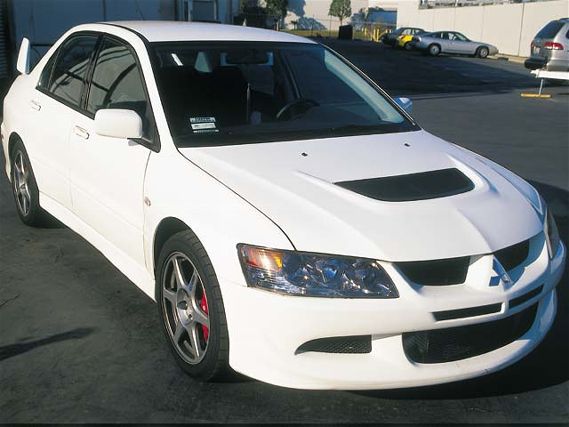 | Power Pages: 2003 Mitsubishi Evolution 8
| Power Pages: 2003 Mitsubishi Evolution 8 Owner: Binh Tran
Dynamometer model: XS Engineering Dynamic Test Systems Dyno
DYNO1
BASELINE
Air Temp @ 64.1 Degrees Fahrenheit
Peak HP 234.9
Peak TQ 246.1
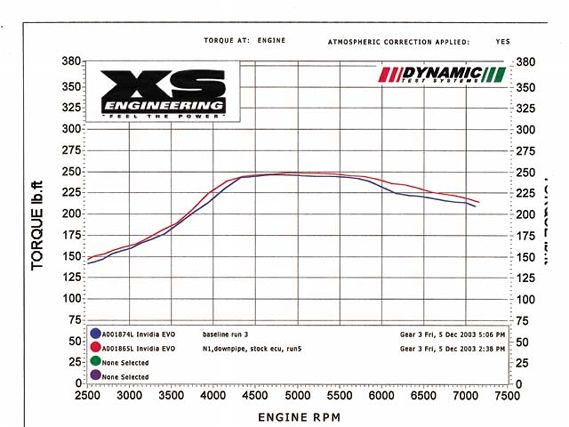 | Power Pages: 2003 Mitsubishi Evolution 8
| Power Pages: 2003 Mitsubishi Evolution 8 Baseline Horsepower: 122.1
Baseline Torque: 124.8
PROS
The Mitsubishi Evolution was delivered to XS Engineering with l500 miles on the odometer. The EVO has rekindled Mitsubishis sluggish automotive sales over the years because of the all-wheel-drive and turbocharged powerplant.
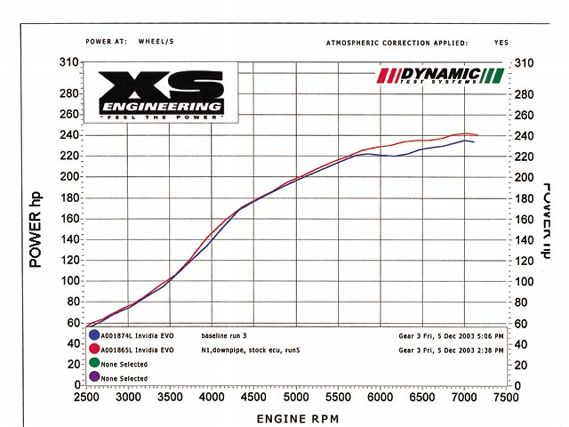 | Power Pages: 2003 Mitsubishi Evolution 8
| Power Pages: 2003 Mitsubishi Evolution 8 CONS
Between 6000 to 6500 rpm the factory EVO stumbles on the dyno, loosing horsepower in the process. Much of the erratic power response is due to the factory timing, which is excessively backed off for Mitsubishi. For this power page 2NR plans to install two aftermarket exhaust components and retune the fuel management with an AEM Engine Management System (EMS) in hopes of smoothing out the graph and, of course, gaining horsepower. Because of that powerplant, however, we were unable to include product shots and put in the AWD charts instead.
DYNO NOTES
Stock Evolution VIII
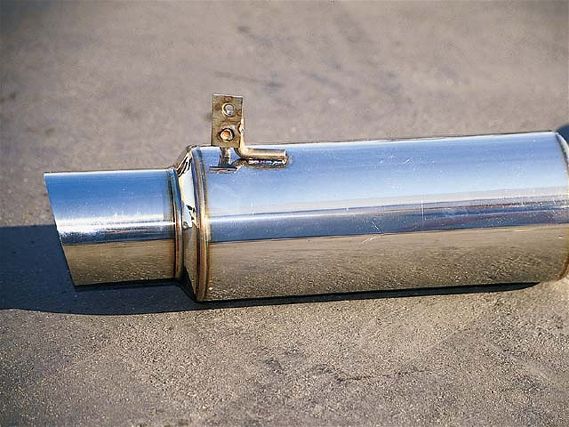 | Power Pages: 2003 Mitsubishi Evolution 8
| Power Pages: 2003 Mitsubishi Evolution 8 DYNO2
Invidia N1 Exhaust
Air Temp @ 64.9 Degrees Fahrenheit
Temperature difference from previous run: 0.8 Degrees Fahrenheit
Peak HP 239.8
Peak TQ 248.9
PROS
Installation of the exhaust on the EVO requires finesse, as the rear exhaust bolts can be a royal pain. Thanks to the lightweight exhaust and smaller rear exhaust canister, the installation was a snap.
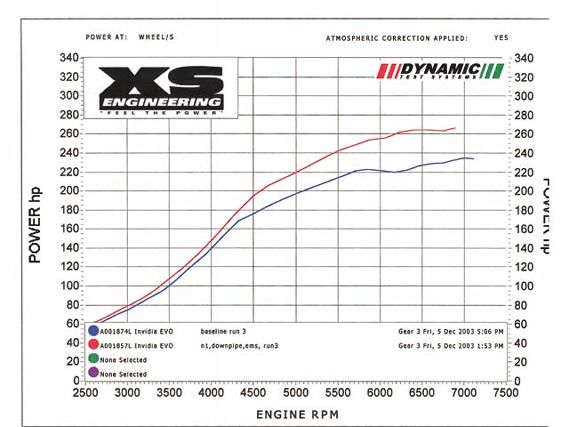 | Power Pages: 2003 Mitsubishi Evolution 8
| Power Pages: 2003 Mitsubishi Evolution 8 CONS
The prototype 80mm stainless unit bolted to the car using a JDM catalytic flange. This caused an improper misalignment of the flange bolts. The final production unit has been corrected and the problematic flange isn't a concern to the consumer.
PARTS INCLUDE
Exhaust, cat gasket, nuts and bolts.
TOOLS REQUIRED FOR INSTALL
14mm socket, 17mm sockets and ratchet, 20mm wrench, extension.
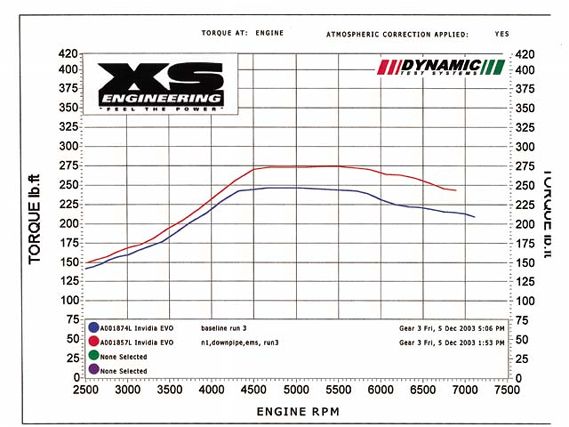 | Power Pages: 2003 Mitsubishi Evolution 8
| Power Pages: 2003 Mitsubishi Evolution 8 DYNO NOTES
After a spin on the rollers the dyno showed a 4.9-horsepower increase as well as a 2.9 increase in torque. As much as 10 hp and 8 lb-ft of torque from 5800 to 7000 rpm were gained with a simple exhaust bolt on.
INSTALL TIME: 45 - 60min
DYNO 3
Invidia downpipe
Air Temp @ 67.3 Degrees Fahrenheit
Temperature difference from previous run: 2.4 Degrees Fahrenheit
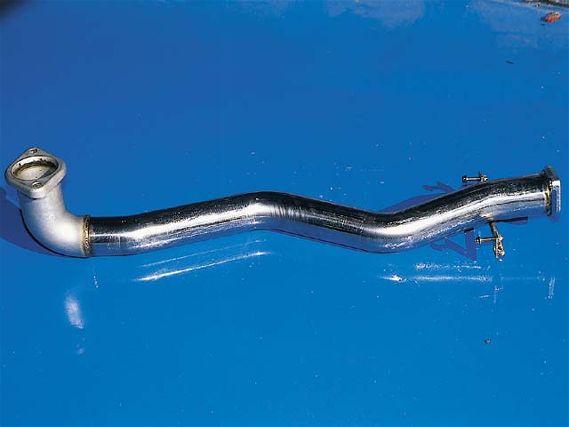 | Power Pages: 2003 Mitsubishi Evolution 8
| Power Pages: 2003 Mitsubishi Evolution 8 Peak HP 241.9
Peak TQ 248.6
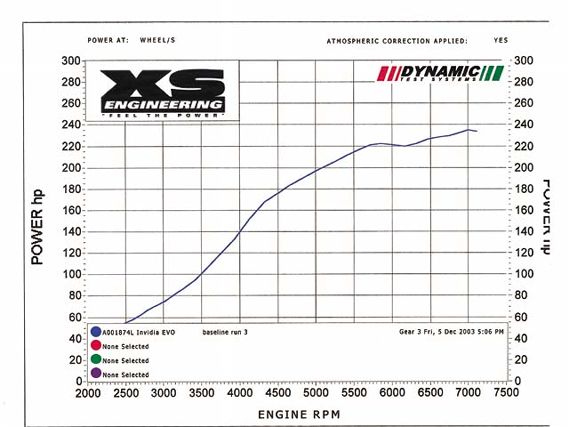 | Power Pages: 2003 Mitsubishi Evolution 8
| Power Pages: 2003 Mitsubishi Evolution 8 PROS
Discarding the restrictive factory downpipe in favor of an 80mm stainless downpipe complements the Invidia exhaust system. Removing the two spring-loaded bolts and stabilizer bars are a simple task anyone can accomplish.
CONS
The aftermarket gasket for the downpipe will have to be closely monitored, as it tends to shift off center when connecting the downpipe to the catalytic. An off-center gasket will affect a proper flow of spent gases and in some cases hurt horsepower.
PARTS INCLUDE
Downpipe, flange-gasket, nuts and bolts.
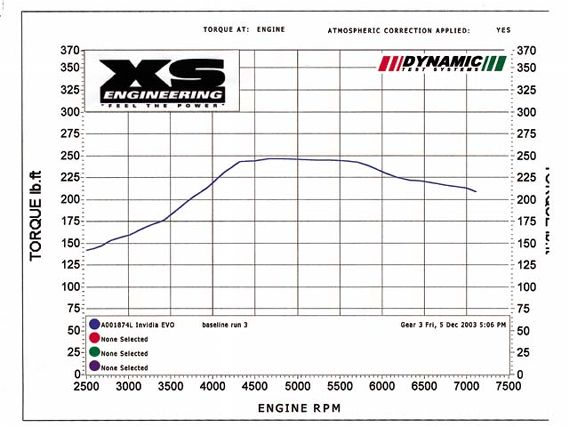 | Power Pages: 2003 Mitsubishi Evolution 8
| Power Pages: 2003 Mitsubishi Evolution 8 TOOLS REQUIRED FOR INSTALL
12-, 14- and 17mm socket, ratchet and extension.
DYNO NOTES
Although final horsepower numbers show a marginal gain (2.1) in horsepower, higher rpm expose as much as a 2-11 horsepower increase from 5800 to redline over stock. With a drop in torque (.3 lb-ft) over the previous run at midrange, we can see that from 4700 rpm to redline is where the largest increase of torque (8 lb-ft) is displayed.
INSTALL TIME: 90min
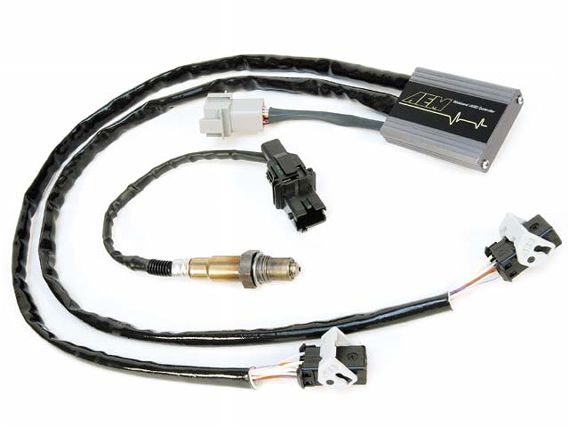 | Power Pages: 2003 Mitsubishi Evolution 8
| Power Pages: 2003 Mitsubishi Evolution 8 DYNO4
AEM EMS Fuel Management/ Uego
Air Temp @ 68.5 Degrees Fahrenheit
Temperature difference from previous runs 1.2 Degrees Fahrenheit
Peak HP 266.5
Peak TQ 274.4
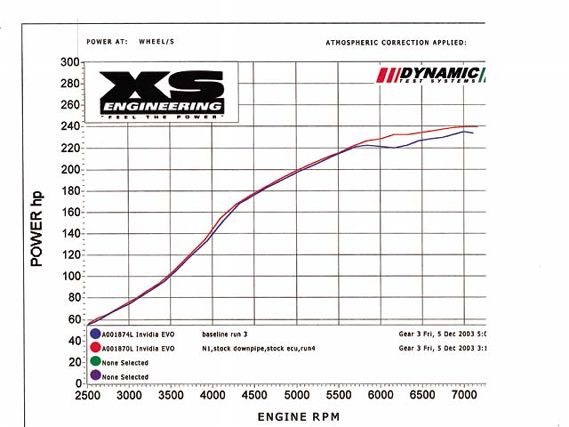 | Power Pages: 2003 Mitsubishi Evolution 8
| Power Pages: 2003 Mitsubishi Evolution 8 PROS
We like the fact that the AEM EMS system is a user-programmable system that plugs directly into a vehicle's factory ECU harness and doesn't require any additional wiring or hardware. The unit allows tuners to program numerous parameters such as engine control, power adders and auxiliary devices. Also used on the power page is an AEM wideband dual sensor UEGO Controller, which replaces the limiting factory narrow band sensor and reduces the vehicle from throwing error codes.
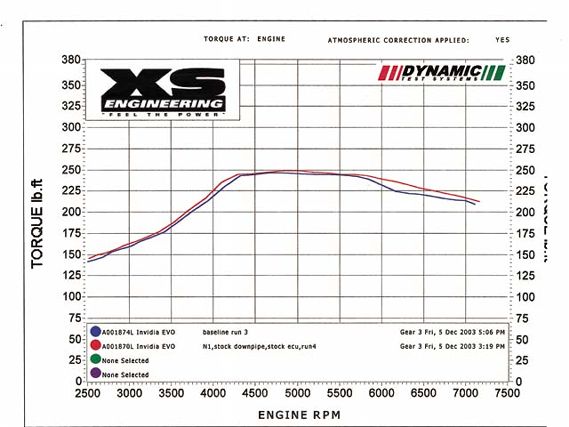 | Power Pages: 2003 Mitsubishi Evolution 8
| Power Pages: 2003 Mitsubishi Evolution 8 CONS
Although it isn't AEM's fault, accessing the rear O2 sensor requires removing the factory seat and pulling back the factory carpet to remove the plugs. If your installing the wires for the 02, don't bust a ghetto job, run the wires through the firewall and not under your car with zip ties.
PARTS INCLUDE
Intercooler, silicone hoses, hose clamps, mounting brackets.
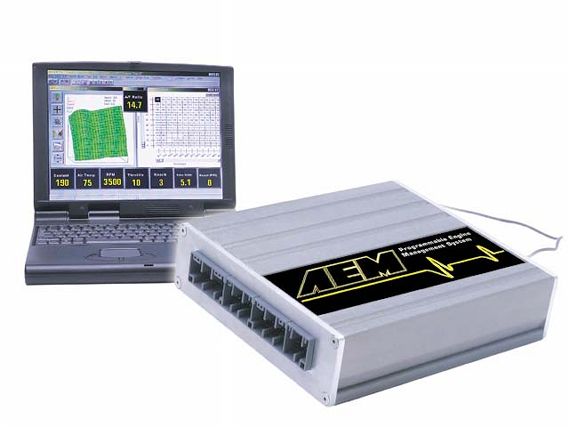 | Power Pages: 2003 Mitsubishi Evolution 8
| Power Pages: 2003 Mitsubishi Evolution 8 TOOLS REQUIRED FOR INSTALL
10-, 12- and14mm socket, extension, ratchets, and screwdriver.
DYNO NOTES
A significant horsepower and torque increase from the baseline runs were accomplished with a quick tune session on the new EMS. Although it's not common to see a large horsepower increase from an aftermarket fuel computer with the EVO, we were quite impressed with the final numbers as hp increased as much as 37 horses and there was a rise of 32 lb-ft of torque. Jason Seibels of AEM states the removal of the air mass sensor can further the horsepower increase if combined with a filter or velocity stack and, of course, an EMS unit. We removed the sensor and proceeded to test the car without a filter as the vehicle lost horsepower throughout the power band.
INSTALL TIME: 60min
Performance Chart HP Level HP+ TQ Level TQ+ Baseline 234.9* 246.1 * 1 Invidia N1 Exhaust 239.8 4.9 248.9 2.8 2 Invidia Downpipe 241.9 2.1 248.6 -0.3 3 AEM EMS Management 266.5 24.6 274.4 25.8 Final 266.5 31.6 274.4 28.3 PARTS COST 1 Invidia N1 Exhaust $ 649.99 2 Invidia Downpipe $ 349.00 3 AEM EMS Fuel Management $ 2335.00 (street price) $1900 AEM dual band Uego controller $ 713.54 (street price) $570.00 MSRP total $ 4047.53CONCLUSION
The EVO began the dyno session at 234.9 hp and finished off at 266.5 hp, an impressive 31.6 hp increase over stock to the wheels. Stock torque figures checked in at 246.1 and ended at 274.4 (a 28.3 lb-ft torque gain over baseline). Thanks to the downpipe and exhaust, along with some additional tuning on the EMS, we are convinced this EVOVIII has some additional ponies just waiting to be unleashed.
